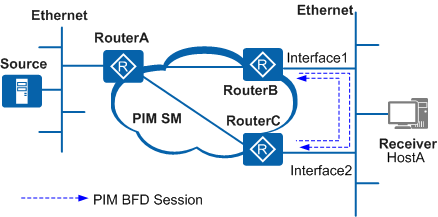PIM BFD
A network device must detect a communications fault between adjacent devices quickly so that the upper layer protocol can rectify the fault and prevent a service interruption.
Bidirectional Forwarding Detection (BFD) provides uniform detection for all media and protocol layers within milliseconds. Two systems set up a BFD session and periodically send BFD control packets along the path between them. If one system does not receive BFD control packets within a specified period, the system considers that a fault has occurred on the path.
Implementation
If the current DR or assert winner on the shared network segment is faulty in a multicast scenario, other PIM neighbors start a new DR election or assert election after the neighbor relationship or the Assert timer times out. Multicast data transmission is interrupted for no less than the neighbor timeout interval or the Assert timer length, usually several seconds.
Because PIM BFD detects the link status on a shared network segment within milliseconds, it responds quickly to PIM neighbor faults. If an interface enabled with PIM BFD does not receive BFD control packets from the DR or assert winner within the detection interval, it considers DR or assert winner faulty. BFD quickly notifies the routing module of the session status, and the routing module then notifies PIM. PIM triggers a new DR election or assert election without waiting for the neighbor relationship or the Assert timer to expire. PIM BFD reduces the service interruption time and improves data transmission reliability.
PIM BFD is applicable only to PIM-SM networks.
Figure 1 shows a shared network segment connected to user hosts. Downstream Interface1 on RouterB and downstream Interface2 on RouterC establish a PIM BFD session and send BFD control packets to detect link status.
RouterB functions as the DR and its downstream interface Interface1 is responsible for forwarding multicast data. If Interface1 fails, BFD quickly notifies the routing module of the session status, and the routing module notifies PIM, which then triggers a new DR election. RouterC becomes the new DR and its downstream interface Interface2 forwards multicast data to the receivers quickly.
